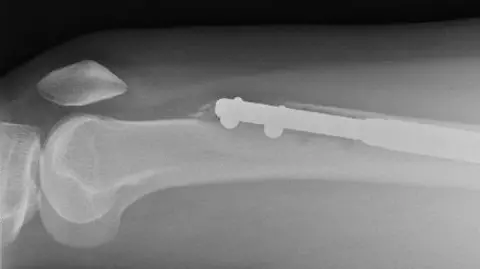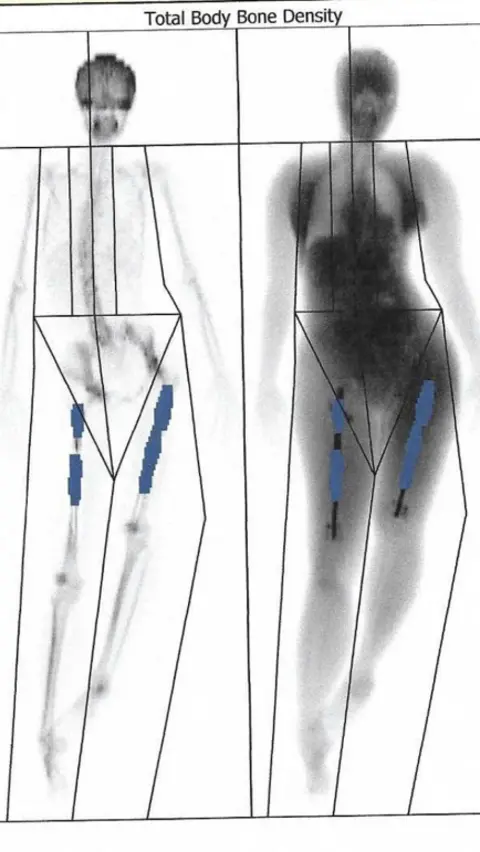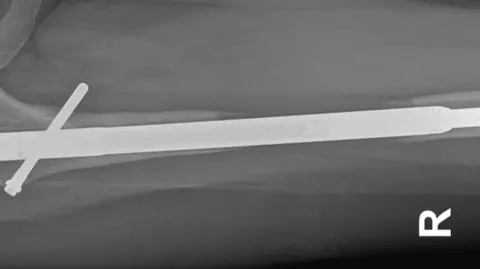 Elaine Foo/Delivered
Elaine Foo/DeliveredWarning: This article contains medical details that readers may find disturbing
Elaine Foo’s legs are covered in thick, purple scars – each one a reminder of a botched leg lengthening procedure.
Since 2016, the 49-year-old has undergone five surgical procedures and three bone transplants, used up all her savings and filed a lawsuit against her surgeon, which was finally settled in July without an admission of guilt.
On one occasion, a metal nail broke through a bone in Elaine’s body, and on another occasion, her legs felt as if they were “roasting from the inside.”
“My journey was a trial by fire – but I survived,” she says.
Her doctor always denied any negligence, stating that some of the problems were due to complications she had been warned about, while others were caused by her own actions.
 Elaine Foo/Delivered
Elaine Foo/DeliveredElaine always hated her height.
“At 12, I was taller than most girls,” she says. “At 14, I was suddenly shorter than everyone else. Over time, it became an obsession. Bigger is better. Bigger is more beautiful. I just felt that taller people had better opportunities.”
In adulthood, the obsession was overwhelming.
Elaine believes she suffers from body dysmorphia, a mental disorder in which a person perceives their appearance as a flaw, regardless of how others view them. The effects of this disorder can be devastating.
At the age of 25, Elaine came across an article about a Chinese clinic where patients had to undergo surgery to lengthen their leg bones. The article contained gruesome details about medieval-looking leg cages and rampant infections. It sounded nightmarish, but it piqued Elaine’s curiosity.
“I know people question the vanity of that statement,” she says. “But when you have body dysmorphia, there is no rational explanation for why you feel so overwhelmingly bad.”
Sixteen years later, Elaine discovered a private clinic in London that offered the procedure. The operation was performed by orthopedic surgeon Jean-Marc Guichet, a specialist in limb lengthening who had even developed his own lengthening device: the Guichet nail.
“It was really a hallelujah moment because I could do it in London and recover at home,” she recalls.
“Dr. Guichet spoke openly about the things that could go wrong. Nerve damage, blood clots, the possibility of bones not healing again.
“But I had done my research, went to a very expensive doctor and expected appropriate medical care. My dream was to grow from 1.57 m to 1.65 m.”
On July 25, she underwent an operation costing around £50,000 that began a process that would change her life.
Leg lengthening is relatively rare but is performed in private clinics around the world and, depending on where it is performed, can cost anywhere from £15,000 to over £150,000.
 Elaine Foo/Delivered
Elaine Foo/Delivered“Waking up was very exciting because it felt like nothing had happened. No pain. But 90 minutes later it starts. It felt like someone was frying my legs. Like they were being roasted from the inside. That first night I screamed until 6 a.m. until I fell asleep screaming.”
Some pain is to be expected during this procedure. During the operation, the leg bones are broken in half and a metal rod is inserted.
The metal rods are gradually extended to increase their length and pull the two halves of the bone apart. This process is intended to increase the patient’s height. The broken bones are intended to gradually grow back together to fill the gap between them.
The operation is complex and represents only the beginning of a long process.
“The extension process takes about two to three months, and after that it takes at least twice as long to get back to a reasonable level of function,” warns Prof. Hamish Simpson, former council member of the British Orthopaedic Association. “It will take most people a year of their lives to do this.”
After the operation, Elaine began the lengthening process. Several times a day, she performed an uncomfortable exercise in which she rotated her legs to trigger the locking mechanism of the bar. This lengthened the nail and her legs grew. But two weeks later, she says, disaster struck.
“I had severe pain in my left leg. Then one night, as I was tossing and turning in bed, I heard what sounded like the crunch of a KitKat, followed by severe pain.”
 Elaine Foo/Delivered
Elaine Foo/DeliveredElaine went for an ultrasound, which confirmed her fears. The nail in her left leg had broken through her femur – the thigh bone, the strongest bone in the human body. She was distraught, but she says Dr. Guichet reassured her.
“He told me you don’t have to worry now. Wait until it heals and when it heals we’ll start the process again.”
They would continue to lengthen Elaine’s right leg while simultaneously planning another surgery for her left leg – which would eventually be lengthened by the same amount as the right.
Elaine says she was told the additional surgery would cost thousands of pounds, but she was happy to pay if it meant she could go through with the procedure.
By September, her right leg had reached the target length of 7 cm. But everything was still not OK. The discrepancy between her right and left leg was causing problems, curving her spine and causing constant pain.
 Elaine Foo/Delivered
Elaine Foo/DeliveredSix weeks later, scans of her right leg showed an alarming lack of bone growth. Her femur was essentially two pieces of bone held together by the metal rod.
Elaine turned to Dr. Guichet for help, who scheduled another operation at a clinic in Milan where he worked. In April 2017, the lengthening process in Elaine’s left leg was restarted, while bone marrow was simultaneously injected into the right leg to stimulate bone growth there. After the operation, Elaine woke up to more bad news.
“Dr. Guichet told me the nail broke when he pulled it out,” she says. “He had a nail from another patient that he could use.” She adds that it would cost even more money.
Three days later, Elaine returned to London, barely able to move but desperate to go home. She says communication with Dr. Guichet deteriorated and by the summer the doctor-patient relationship had broken down.
 Elaine Foo/Delivered
Elaine Foo/DeliveredShe didn’t know who else to turn to and in July 2017 she managed to see a specialist orthopaedic surgeon on the NHS.
She says the specialist told her, “This is not going to be a short trip.”
“I had to prepare myself for at least five years of treatment before I was fully cured,” she says.
Eight years after the first surgery, Elaine is still recovering from her emotional and physical scars. She has various mobility issues and says she suffers from post-traumatic stress disorder.
“From 2017 to 2020, I hid from the world. I was single, unemployed, penniless and disabled.”
But she has recently found some closure. A four-year legal battle was finally resolved in July when Dr. Guichet agreed to pay Elaine a “substantial” sum to settle her case against him – without any admission of guilt.
The surgeon’s lawyer denied any negligence on the part of Dr. Guichet, telling the court: “Dr. Guichet’s position is that there was no negligence, that the fracture and delayed bone healing were unfortunate, non-negligent complications that Ms. Foo was warned about prior to surgery, and that the limited bone regeneration on the right side was exacerbated by Ms. Foo’s undisclosed use of antidepressants and by her intentional extension of the nail in her right leg beyond the agreed length.”
He also claimed in court that Ms Foo had “frequently refused” to follow Guichet’s advice and neglected her rehabilitation and physiotherapy.
Elaine denies all of these allegations. She says the antidepressants had no connection with the complications and blames the doctor for what happened to her.
Elaine thought she was safe because she paid so much. But she paid more than just a financial price.
“I lost the best years of my life. I know people like to hear the word regret, and if someone asked me today, ‘Would you have done it if you had known you would have to go through all this?’ I would definitely say, ‘No, thank you very much.'”




